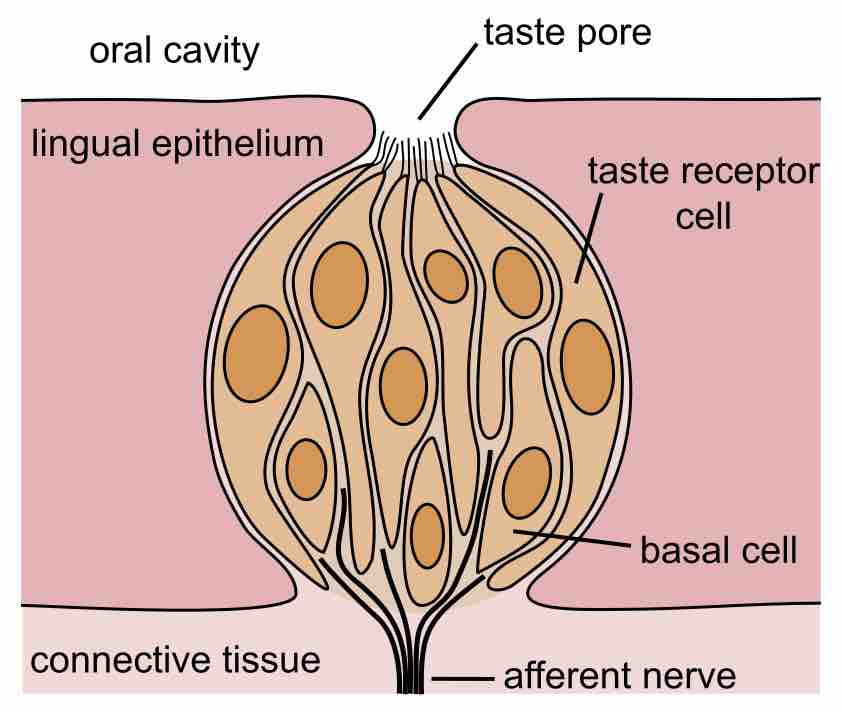The gustatory system creates the human sense of taste, allowing us to perceive different flavors from substances that we consume as food and drink. Gustation, along with olfaction (the sense of smell), is classified as chemoreception because it functions by reacting with molecular chemical compounds in a given substance. Specialized cells in the gustatory system that are located on the tongue are called taste buds, and they sense tastants (taste molecules). The taste buds send the information from the tastants to the brain, where a molecule is processed as a certain taste. There are five main tastes: bitter, salty, sweet, sour, and umami (savory). All the varieties of flavor we experience are a combination of some or all of these tastes.

The Mouth
A cross-section of the human head, which displays the location of the mouth, tongue, pharynx, epiglottis, and throat.
Tongue and Taste Buds
The sense of taste is transduced by taste buds, which are clusters of 50-100 taste receptor cells located in the tongue, soft palate, epiglottis, pharynx, and esophagus. The tongue is the main sensory organ of the gustatory system. The tongue contains papillae, or specialized epithelial cells, which have taste buds on their surface. There are three types of papillae with taste buds in the human gustatory system:
- fungiform papillae, which are mushroom-shaped and located at the tip of the tongue;
- foliate papillae, which are ridges and grooves toward the back of the tongue;
- circumvallate papillae, which are circular-shaped and located in a row just in front of the end of the tongue.
Each taste bud is flask-like in shape and formed by two types of cells: supporting cells and gustatory cells. Gustatory cells are short-lived and are continuously regenerating. They each contain a taste pore at the surface of the tongue which is the site of sensory transduction. Though there are small differences in sensation, all taste buds, no matter their location, can respond to all types of taste.

Taste Buds
A schematic drawing of a taste bud and its component pieces.
Tastes
Traditionally, humans were thought to have just four main tastes: bitter, salty, sweet, and sour. Recently, umami, which is the Japanese word for "savory," was added to this list of basic tastes. (Spicy is not a basic taste because the sensation of spicy foods does not come from taste buds but rather from heat and pain receptors.) In general, tastes can be appetitive (pleasant) or aversive (unpleasant), depending on the unique makeup of the material being tasted.There is one type of taste receptor for each flavor, and each type of taste stimulus is transduced by a different mechanism. Bitter, sweet, and umami tastes use similar mechanisms based on a G protein-coupled receptor, or GPCR.
Bitter
There are several classes of bitter compounds which vary in chemical makeup. The human body has evolved a particularly sophisticated sense for bitter substances and can distinguish between the many radically different compounds that produce a bitter response. Evolutionary psychologists believe this to be a result of the role of bitterness in human survival: some bitter-tasting compounds can be hazardous to our health, so we learned to recognize and avoid bitter substances in general.
Salty
The salt receptor, NaCl, is arguable the simplest of all the receptors found in the mouth. An ion channel in the taste cell wall allows Na+ ions to enter the cell. This depolarizes the cell and floods it with ions, leading to a neurotransmitter release.
Sweet
Like bitter tastes, sweet taste transduction involves GPCRs binding. The specific mechanism depends on the specific molecule flavor. Natural sweeteners such as saccharides activate the GPCRs to release gustducin. Synthetic sweeteners such as saccharin activate a separate set of GPCRs, initiating a similar but different process of protein transitions.
Sour
Sour tastes signal the presence of acidic compounds in substances. There are three different receptor proteins at work in a sour taste. The first is a simple ion channel which allows hydrogen ions to flow directly into the cell. The second is a K+ channel which has H+ ions in order to block K+ ions from escaping the cell. The third allows sodium ions to flow down the concentration gradient into the cell. This involvement with sodium ions implies a relationship between salty and sour tastes receptors.
Umami
Umami is the newest receptor to be recognized by western scientists in the family of basic tastes. This Japanese word means "savory" or "meaty." It is thought that umami receptors act similarly to bitter and sweet receptors (involving GPCRs), but very little is known about their actual function. We do know that umami detects glutamates that are common in meats, cheese, and other protein-heavy foods and reacts specifically to foods treated with MSG.